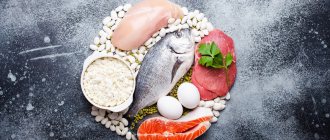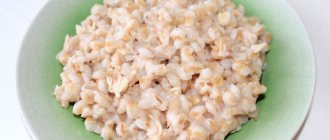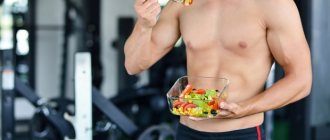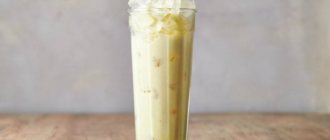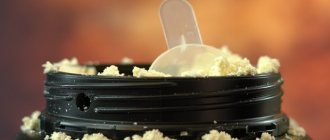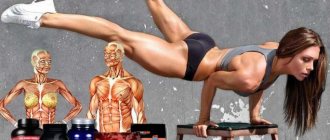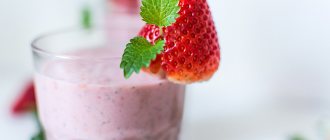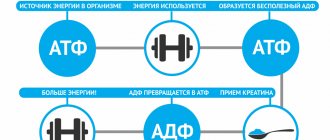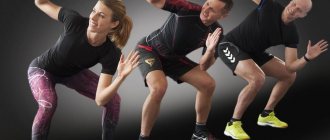Achieving a sculpted torso and rounded muscles takes a lot of work and desire. With a skillful approach, it is possible to achieve noticeable results in a few months. The main thing is to understand that in addition to strength exercises, sweating in the gym, and incredible loads, there is another important component on which half the success depends - proper nutrition for gaining muscle mass for men.
Understanding the processes occurring in the body, knowledge of the influence of food on the formation of a figure helps to increase muscles steadily, evenly, without stretch marks.
Please note that proper nutrition for gaining muscle mass differs from the generally accepted diet for a healthy lifestyle, and it is not similar to a diet for weight loss. Let’s look at what food should be for bodybuilders in more detail later.
Rules to follow when gaining weight
Amount of protein
Maxim Musaev
teacher at the College of Fitness and Bodybuilding named after. Ben Vader, methodologist, trainer of the highest category, head of the fitness department with more than 10 years of experience. Athlete and judge of the Russian Bodybuilding Federation
– What is the maximum amount of protein should be in the diet? If during strength training an athlete uses working weights above 70% of the maximum, then he needs to increase the amount of protein to 2 g per 1 kg of body weight. In all other cases, the protein norm will be about 1.5 g per 1 kg of body weight. Those who have problems with the gastrointestinal tract should take more accessible proteins instead of dense and difficult to digest proteins - beef and lamb should be replaced with eggs, fish, seafood and milk.
Calorie surplus
When gaining muscle mass, you should always follow the rule of calorie surplus. This means that you need to consume more calories per day than your body burns. The caloric surplus should be 400–500 kcal, and the level of surplus should be daily, and not just on the day of training. Naturally, in this case, the source of calories should be only high-quality products, and not all sorts of fatty sweets, fast food, etc.
Nagima Semchukova
certified nutritionist, member of RoSNDP
– If we talk about people who want to gain or lose weight, the main rule always applies here: if you want to lose weight, you need to consume less energy than you expend. And vice versa: if you want to gain weight, you need to consume more energy than you expend.
The total energy requirement of the body consists of three components:
- Basic exchange
– the amount of energy that a person consumes at rest. Even if you do nothing, sleep, lie on the couch, your body continues to work. It needs energy for the heart to beat, for the blood to flow through the veins, for you to breathe, for the kidneys to perform their function, etc. These are the basic needs of the body. You cannot go below the basic exchange rate.
- Nutritional thermogenesis
- the amount of energy required to digest food. To get energy from food, you need energy!
- Physical activity
– the amount of energy required to maintain physical activity.
When a person loses or gains weight, the caloric content of the diet should change due to the third component. The more active a person is, the more he plays sports, the more energy he needs. And vice versa: the less active a person is, the lower the calorie content of his diet should be.
Important!
Lack of body weight can indicate possible diseases, gastrointestinal pathologies, nervous disorders, and lifestyle features. Before gaining weight, you need to consult with your doctor, calculate your body mass index and identify possible contraindications. The same applies to those who want to do strength training to gain muscle mass.
Stretch all your core muscles
The foundation of great abs is a strong core, which helps stabilize the entire body. Your core muscles—the rectus abdominis, obliques, and transversus abdominis, lower back, and pelvis—are the entire system that supports your body when you stand, walk, perform daily activities, or exercise. It is very important to strengthen all of them, not just the abs.
A strong core can help you get the most out of any workout.
In fact, the more you work your entire body, the better it will be for your abs. Almost any compound or full-body exercise requires significant work of the abdominal muscles, so you can pump up your abs with programs that do not focus on crunches.
Basics of sports nutrition - proper distribution of nutritional supplements
To gain muscle mass, in addition to a calorie surplus, it is necessary to maintain the correct balance of proteins, fats and carbohydrates (BJU). On average, the distribution of BJU per 1 kg of body weight should be as follows:
- Proteins: 1.5–2 g
- Fat: 1–1.3 g
- Carbohydrates: 4–6 g
How to start eating right?
As expert Maxim Musaev advises, to create an optimal diet, you cannot completely cross out your entire diet; you need to smoothly go through several stages.
- Fixing the current calorie content and ratio of BZHU
. We weigh the food, write it down and determine how much and what we are eating at the moment.
- Identifying nutrient deficiencies and excesses.
Most often, proteins and carbohydrates need to be increased and fats reduced. All daily calories should be distributed evenly throughout the day in the proportion of 30% for breakfast, 40% for lunch and 30% for dinner. In this case, the amount of protein at one time should not exceed 30 g. This is approximately 150 g of chicken breast or 3 egg whites. All excess protein in certain cases can be harmful to the health of the athlete. If three meals are not enough for the required calorie content, then add additional meals.
- Improving the quality of the food basket.
It is not recommended to immediately abandon your previous diet. It is necessary to consistently replace sources of proteins, fats and carbohydrates with better and more digestible ones.
How often should you make adjustments to your diet?
All dietary adjustments can be made every 1-2 weeks. And each time you need to take into account changes in body weight.
How quickly can muscle mass increase?
At the initial stage, you can expect weight gain of up to 1–2 kg per month. After a few months of training, it is possible to slow down to 300–500 g per month or even stop gaining. A lot depends on age. The younger the body, the more anabolic hormones it has, which are necessary for protein synthesis in the body, the greater the likelihood of gaining muscle mass. With age, the amount of hormones decreases, and, accordingly, after 35 years it is problematic to expect noticeable hypertrophy.
Men's diet for a week for losing weight on the stomach and sides
For good health, it will not be superfluous to have a varied diet. Therefore, the diet presented in Table 1 is aimed precisely at this.
| Days of the week | Breakfast | Dinner | Dinner |
| Mon | Fried eggs Light salad with cabbage, carrots and apple Orange Green tea | Light soup with turkey | Vegetable stew Chicken breast Kefir |
| W | Rice porrige. Fruit salad Fresh juice | Spinach cream soup | Stewed zucchini with lean beef Natural yogurt |
| Wed | Omelette Low-fat cheese Sugar free coffee | Ear Salad of tomatoes and cucumbers | Rice Kefir |
| Thu | Buckwheat porridge with mushrooms Tomatoes Green tea | Borsch. Rye bread Vegetables | Vegetable stew Rye bread |
| Fri | Skim cheese Eggs Juice | Mushroom soup Low-fat cheese | Baked trout with vegetables and potatoes |
| Sat | Pearl barley porridge. Pear. Yogurt | Tomato soup Fruit salad | Rice with mushrooms Yogurt |
| Sun | Oatmeal with berries. Grapefruit | Turkey fillet Light tomato and cucumber salad | Chicken breast with zucchini Kefir Fruit |
In between standard meals, you can have snacks consisting of your favorite fruits, nuts, yogurt or kefir.
Can body type affect weight gain?
Numerous studies by scientists prove that genes directly affect both strength indicators and the ability to gain muscle mass.
For information
A 2007 study found that when doing the same strength training, so-called “genetic losers” failed to increase muscle cross-sectional area, while people with high gene expression (that is, a predisposition to muscle growth) increased their gains by 58%.
A 2010 study found that genes determine 40–70% of body weight.
In addition, genetics influences your metabolic rate, fat levels, strength performance, and calorie intake. In such cases, experts talk about a “genetic ceiling” - a level above which a person is not able to gain weight. However, heredity is only one of the factors influencing weight gain. Proper nutrition, a balanced diet, optimal training - all this also affects whether you continue to gain weight or not.
Relief press. Diet
The diet presented in the table was developed by nutritionists specifically for losing weight in the abdominal area. And in combination with strength training, it makes it possible to get beautiful and sculpted abs.
| Diet | |
| Breakfast |
|
| Dinner |
|
| Dinner |
|
What foods should definitely be in your diet?
To gain weight through muscles, it is not enough to simply eat more food, emphasizes nutritionist Nagima Semchukova. For athletes, in most cases, a normal diet is suitable, balanced in the quantity and quality of proteins, fats and carbohydrates.
Carbohydrates are important for humans from the point of view of a stable source of glucose - the main source of energy for our body. To maintain adequate energy levels and optimal recovery, it is important to provide yourself with a sustainable source of glucose.
Since protein is a building material for our body, it is also necessary to pay attention to its sufficiency in the diet. The body of a healthy person has a supply of fats and carbohydrates, but practically no supply of protein, so it is extremely important to monitor its amount, but do not forget that too much protein in the diet is also harmful.
Top 5 High Protein Foods You Should Have in Your Diet
When choosing high-protein food, you need to remember not only the protein content per 100 g of product, but also the amino acid digestibility coefficient and nutritional value. Athletes may eliminate many seemingly protein-rich foods from their diets because they are high in fat or have low digestibility.
For information
Protein digestibility is usually calculated using the PDCAAS scale, which shows how well the amino acid composition of a product will meet human needs. Products with the best digestibility have a coefficient of 1.0.
Eggs
Digestibility coefficient: 1
Protein content per 100 g: 12 g
Egg whites are not only good for muscle building: the leucine they contain helps reduce the rate of muscle protein breakdown.
Cottage cheese
Digestibility coefficient: 1
Protein content per 100 g: 16 g
The basis of cottage cheese is the slow protein casein, so athletes usually eat cottage cheese before bed or before a long break between meals.
Chicken breast
Digestibility coefficient: 0.92
Protein content per 100 g: 30 g (in boiled product)
Athletes often choose breast meat over other parts of chicken due to its low fat content. But other parts of the chicken are also suitable if you do not have problems with cholesterol.
Beef
Digestibility coefficient: 0.92
Protein content per 100 g: 25 g (in boiled product)
Research shows that beef protein is as good as whey protein. This is a high-quality protein that contains all the necessary amino acids for weight gain.
Trout/salmon
Digestibility coefficient: 0.78
Protein content per 100 g: 20–22 g
In addition to these species, you can use tuna, pink salmon or mackerel. In addition to protein, fish contains many beneficial omega-3 acids. But you need to remember that the fattier the fish, the higher its omega-3 content.
Simple exercise for the press
Classic forearm plank
- Run for maximum time
- Body Part: Press Equipment: No
Exercise with a gymnastic roller
- 3 sets of 5-7 reps
- Body Part: Press Equipment: Other
Butt lift
- 3 sets of 15-20 reps
- Body Part: Press Equipment: No
Crunches with legs on a fitball
- 3 sets of 15-20 reps
- Body part: Press Equipment: Fitball
Raising legs to arms from a lying position
- 3 sets of 15-20 reps
- Body part: Press Equipment: Body weight
Add to Calendar * Add to My Workouts * Print Workout
* — The service is in beta testing
Alternatively, you can combine more complex sets of exercises.
Recommended meal plan
As expert Semchukova emphasizes, nutrition during sports has two main goals:
- improved recovery;
- improved performance.
There are no uniform rules that would set for everyone the exact time when to eat before/after training. This is very individual and depends on:
- duration of training;
- intensity of activity;
- training frequency;
- athlete's goals;
- athlete's body composition;
- his individual intolerance.
In general, people who exercise for health, just like everyone else, are advised to start with the simplest rules. And only when the athlete consistently adheres to the standard diet, you need to see whether it is really worth complicating the rules of the game.
Example menu
It is worth noting that the diet for abs for men and the diet for abs for women are somewhat different from each other. For the female body, it is important what origin the fat is consumed in food. Contrary to the previous opinion that the diet of people who exercise their abdominal muscles should consist of high-calorie dishes, modern scientists have proven that fat will never turn into protein and will remain in the body only as fat.
The female body is prone to accumulating body fat much more than the male body. Therefore, women are recommended to give preference to unsaturated fats of vegetable origin, for example, olive oil is considered ideal.
For those who are working on strengthening their abdominal muscles, you can focus on the following menu:
- Breakfast: protein shake 350 g;
- First snack: raw vegetables and 50 g peanut butter;
- Lunch: poultry, grain bread, apple, glass of low-fat milk;
- Second snack: almonds, fresh berries;
- Dinner: meatballs, one onion, clove of garlic, tbsp. a spoonful of flax seeds, half a glass of crackers (crushed), grain bread, half a glass of grated mozzarella cheese;
- Third snack: protein shake 350 g.
Sports nutrition for weight gain
Expert Maxim Musaev says:
– If a person plays sports, then over time he simply needs to use sports nutrition. It should be a supplement to your regular diet, not a replacement for it. Sports nutrition has a significant advantage: all products have high bioavailability, that is, they enter the blood very quickly. This is largely achieved through consumption in liquid form - for example, proteins and gainers. Most other products also need to be dissolved in water.
- Whatever sport the athlete does, he needs to consume 1-2 times a day. protein
in the form of whey isolate as an additional source of high-quality protein with a complete set of amino acids.
- If your workouts are aimed at gaining muscle mass, then protein-carbohydrate mixtures are better - gainers
, which can easily increase calorie content by 400–500 kcal per day. This is important for such training.
How to lose weight after forty?
At this age, it is necessary to focus on protein-rich foods. It won’t hurt to include fiber in your diet, but you’ll have to give up flour dishes and fast food.
Protein products are extremely beneficial for the body:
- Cleanse the body of waste and toxins.
- Helps strengthen the immune system.
- They have a beneficial effect on the circulatory and digestive systems.
It is better to start the day with a healthy breakfast consisting of porridge, eggs and green tea. Protein-rich foods will saturate the body for a long time. In the middle of the day, it is recommended to have lunch with low-fat fish, boiled potatoes and vegetables. And at the end of the working day you can eat a piece of lean beef.
Microbes won't be happy
By the standards of history, spices have only recently become a gourmet ingredient. Initially, they were widely used to veil products of dubious quality and for preservation. The first was dealt with well by volatile aromatic substances, which could overpower many other odors, while the second was dealt with by antibacterial agents in the composition of spices. Cloves, ginger, turmeric, garlic and rosemary top the list of spices that are harmful to pathogens and therefore beneficial for people during the cold season. Of course, ginger tea after this does not become a cure for pneumonia, but it is quite a means of prevention and support of the immune system.
The antioxidants and beneficial substances of most spices are better absorbed with fat. Surprisingly, people intuitively understood this even before the era of mass scientific research: in many gastronomic cultures, spices are usually fried in oil or taken with fatty foods. Fortunately, extra calories should not disrupt your slim figure: the active substances in spices usually stimulate blood flow and, therefore, the metabolic rate.
Dish recipes
Protein cocktail
How to make a protein shake to build muscle?
- 200 grams of milk with one percent fat content;
- Two tablespoons of yogurt;
- Half a glass of oatmeal, pre-soaked in water;
- 50 g peanut butter;
- 60 g of protein in any flavor, including chocolate;
- Crush six ice cubes.
Mix all. You will get about two servings: for the morning and for the evening.
Steak with vegetables
- 50 g olive oil;
- Two carrots;
- Finely chopped broccoli (cup);
- Two pieces each of capsicum and bell pepper;
- 350 g steak;
- A quarter cup of soy sauce;
- Four cups of cooked rice (brown variety).
Heat the oil in a frying pan, add the vegetables, simmer until soft, then add the meat. After everything is ready, serve the sauce and boiled rice.
Water and its quantity
Gaining good muscle mass is impossible for those who do not pay attention to water - the presence of a sufficient amount of moisture in the body. A deficiency is fraught with a lack of progress in the task assigned to the athlete. The optimal daily intake for those who build muscle is considered to be from two to four liters. The exact amount is determined by the weight of the athlete.
You should not drink while eating. This creates an obstacle to the natural process of digestion and absorption of nutrients, preventing the digestive system from working at one hundred percent. Water is best consumed between meals.
Reasons for weight loss
Before increasing weight, you should find out the reason for thinness.
Most often, the “culprits” for lack of muscle mass are:
- eating disorders (anorexia nervosa, serious mental disorder);
- problems with the thyroid gland. Hyperthyroidism can cause increased metabolism and, as a result, weight loss;
- Celiac disease is the most severe form of gluten intolerance;
- diabetes mellitus – uncontrolled diabetes (mostly type 1) can lead to significant weight loss;
- oncological diseases - malignant tumors often “eat up” a large number of calories;
- infectious diseases - for example, tuberculosis, HIV/AIDS.
